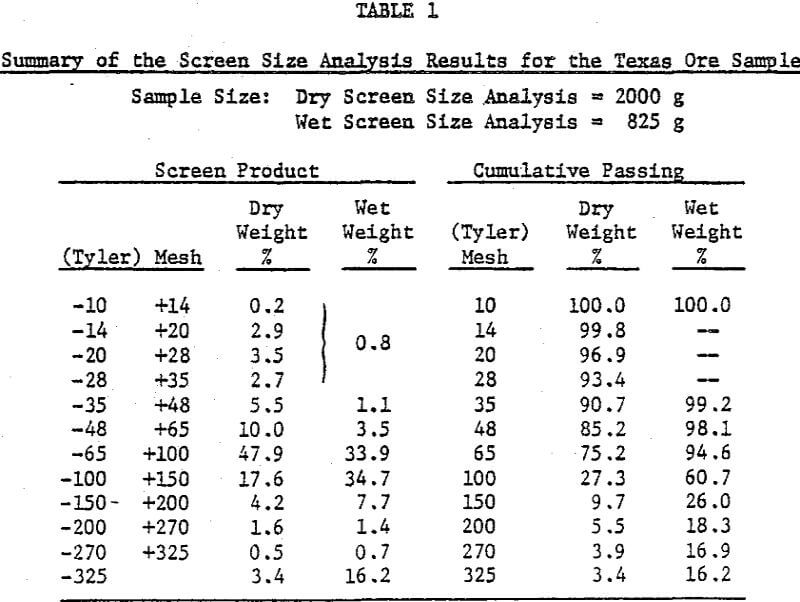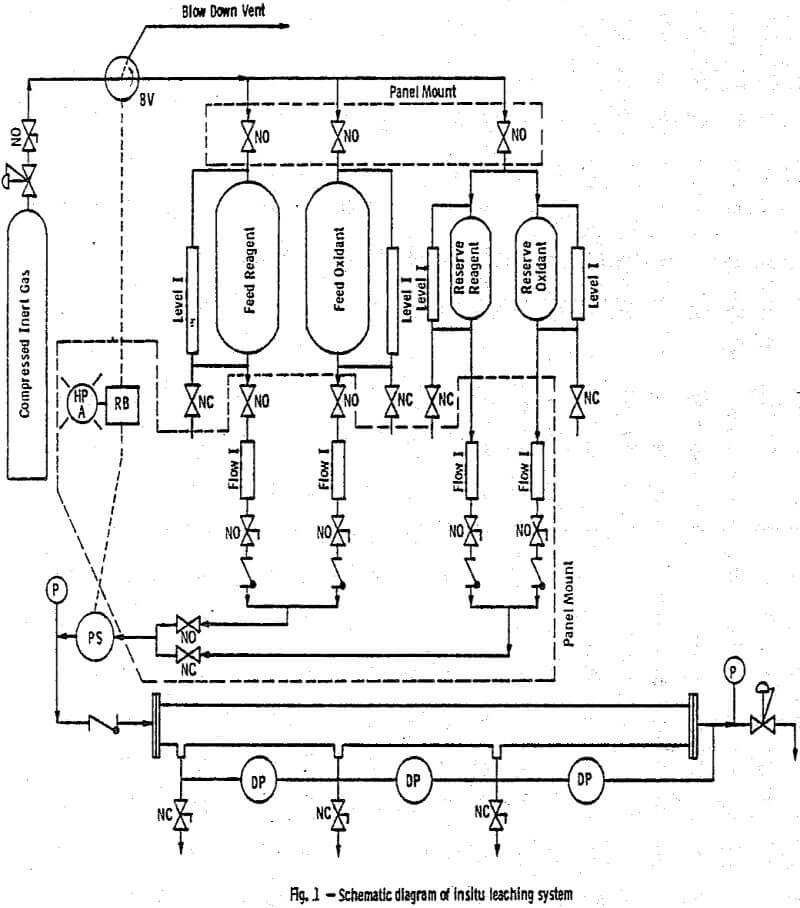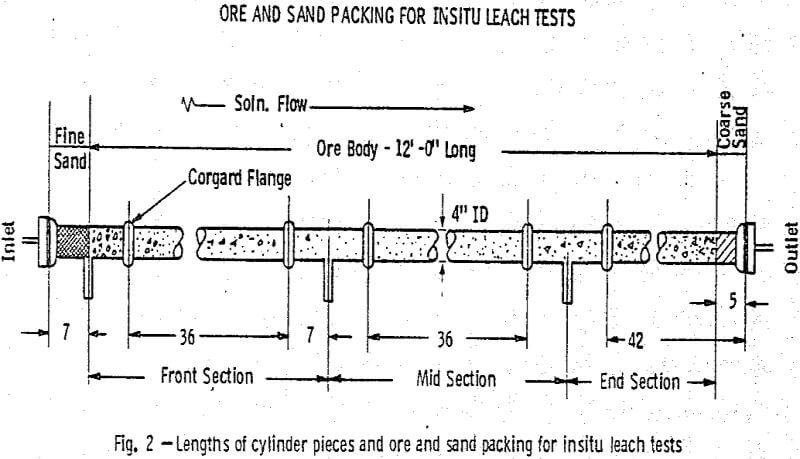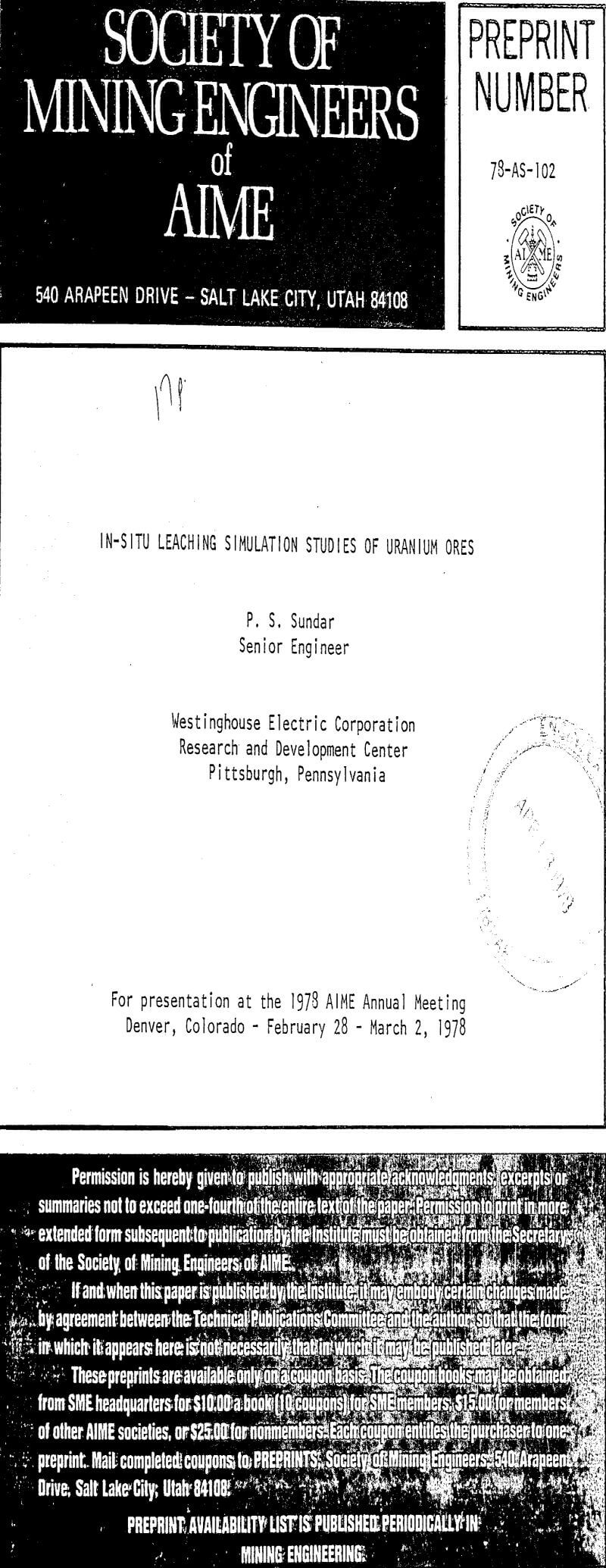Table of Contents
A laboratory method for the simulation of in-situ leaching of uranium was developed under contract to the Interior Department’s Bureau of Mines. Simulation tests using sulfuric acid, ammonium bicarbonate and sodium carbonate as reagents, and hydrogen peroxide as oxidant were carried out with representative ores from Texas and Wyoming. The tests not only yielded recovery rates of uranium and permeability changes, but also qualitative inferences on the chemical and physical phenomena which occur underground. Leaching with basic solutions was found to be kinetic constrained and with acid solutions, equilibrium constrained. The rapid permeability changes observed when leach solutions were introduced, were probably caused by gas blockages in the packing. Precipitation of calcite or gypsum and the reaction of clay to leach solutions had slow and gradual effect on the packing permeabilities.
The In-Situ Simulation System
The following features were considered in arriving at an acceptable design:
- Ore sample container of representative geometry (cylindrical, rectangular slab, etc.) capable of operating at temperature and pressure constraints occurring in in-situ leaching, o Adequate sampling ports for obtaining solution and ore samples for analysis and characterization.
- Sufficient Instrumentation to monitor all operating parameters (flow, pressure, temperature, etc.) and to allow identification of the state of the system.
- A leach solution(s) feed system to the ore sample container that does not superimpose any additional changes in the bed characteristics such as packing density, voidage, homogeneity, etc.
- Provision for use of oxidant injection into the feed.
- Visibility of the leach process in progress,
- Safe operating conditions,
- Ease of maintenance and assembly.
The feed section consists of two primary Type 316 stainless steel captive gas tanks (one each for the leach reagent and the oxidant solutions) of 16 gal. capacity with PVC liners and two similar reserve captive gas tanks of 2 gal. capacity each. The PVC liners separating the solution and the pressurizing gas were introduced in order to prevent nucleation of the dissolved pressurizing gas in the ore packing as the static pressure decreases. This is particularly true of inert gases (argon or nitrogen), if used. However, the solubility of gas can be exploited in tests with gaseous oxidants such as oxygen, to supply the oxidant to the ore. The reserve tanks serve as feed tanks during recharging of the primary feed tanks. The feed section is capable of delivering solution up to a maximum working pressure of 120 psig.
The Simulation Test Method
The development of a packing method that would consistently reproduce packing permeability was paramount to the success of the simulation tests. Based on limited data on the field permeabilities of uranium mineralizations, a water permeability in the range of 0.5 to 2.5 darcy was preferred in developing a packing method.
The correlation (Darcy equation) used in the estimation of the permeability during the simulation tests is given by
ΔP/L = α·u·V……………………………………………………………..(1)
where ΔP/L = Flow pressure gradient, atm/cm
V = Liquid superficial velocity, cm³/ cm² sec.
u = Solution viscosity, centipose
l/α Δ Permeability, Darcy (by definition)
The equation (1) could be rewritten as

where V’ = Solution Volumetric flow, cm³/min
A = Packing area of cross-section, cm²
ΔP’/L’ = Flow pressure gradient, psi/in.
and L’ = Packing length, inches.

The ore samples were packed into the glass columns according to the methods developed for each ore sample. It was opted to pack the ore dry to minimize preoxidation during the packing operation. The columns were packed in a vertical position and were leached in a horizontal-position to eliminate any gravity effects on solution flow, fines migration and packing density variations due to its own weight. The packings were examined visually for voids, faults and gross segregation prior to acceptance for water flow test. The packings were flow tested using de-ionized water over a period of 125-200 hours to ensure correct permeability and stability.
At the termination of the leach test, the packing section was disconnected from the system and allowed to drain vertically. After draining, the packing was returned to a horizontal position for approximately 72 hours to allow the remaining moisture to distribute uniformly. The pressure profile along the length of the column was recorded every 6 hours to permit estimation of permeability changes. The cumulative product solution volume was measured every 48 hours and a solution sample was collected for uranium analysis.
Simulation Test Results
In-situ leach simulation tests were carried out with each of the ore samples acquired using deionized water, 1.0 g/l ammonium bicarbonate -0.5 g/l peroxide, 1.0 g/l sodium carbonate -0.5 g/l peroxide, and sulfuric acid solution of pH – 1.0.
The simulation leach studies also sought to derive qualitative inferences on the possible leach controlling mechanism, effect of solution flux upon recovery rate, and the physical phenomena occurring in the simulated ore body (packing) during the test.
In the following only the permeability variations and the uranium recovery rates observed during the simulation leach tests with the Wyoming ore sample using deionized water, 1 g/l ammonium bicarbonate -0.5 g/l peroxide, 1 g/l sodium carbonate -0.5 g/l peroxide and sulfuric acid of pH = 1.0, and that with the Texas ore sample using deionized water and sulfuric acid (pH = 1.0) are summarized.
The uranium recovery rate observed, and the total carbonate and bicarbonate concentration of the product solutions (expressed as bicarbonate ion concentration). Because of the low product solution pH (< 4.8) in the case of the Texas ore, the sulfate ion concentrations (principal anion) instead of the carbonate-bicarbonate levels, were determined. In both the tests, the uranium recovery rate was directly proportional to the principal anion concentration.in the solution.
This test is an example of shift in the system operation mode from constant flow to constant inlet pressure. Adjustments to maintain constant flow were made only during the first approximately 50 hours, as the maximum acceptable inlet pressure (45 psig) was attained at the end of this period. The leach system was allowed to drift with respect to volumetric flow rate over the remainder of the test. During this test, it was difficult to maintain an equal volume flow of each solution (reagent and oxidant). The actual oxidant-to-reagent flow ratio varied from 0.82 to 2.5 based on average flow rates calculated using the volume changes in the feed tanks.
Based on the analysis of the ore before and after the leaching operation, the overall uranium recovery achieved was 78.8%. Even though the bicarbonate concentration, varied over the duration of the test, the recovery rate seemed unaffected by it. This is due to the presence of sufficient anion to complex the available uranium, even at the minimum reagent concentration of 570 ppm obtained at oxidant to reagent flow ratio of 2.5. The uranium concentration levels observed in solution were typical of in-situ leach solution levels. The equilibrium pH observed was nearly constant in the range of 7.80 to 8.20.
In packing the column for the leaching of the Wyoming ore using sodium carbonate-peroxide solution, a 50-50 mixture of sand and ore was used at the inlet instead of the sand only. This was done to give the inlet section additional mechanical stability. Upon introduction of the 1.0 g/l sodium carbonate -0.5 g/l peroxide leach solution (pH 9.0), the permeability of the column decreased very rapidly, leading to loss of control over the feed composition.
The permeability and flow variations observed during sulfuric acid leaching of the Wyoming ore sample. Upon acid injection the front ore section permeability decreased rapidly in the first 50 hours (from 2.0 to 0.25 darcy), followed by a gradual decrease at a very slow rate. A similar decrease but of lower magnitude was observed of the middle and the end section permeabilities. However, gradually recovered (in approximately 300 hours) to near their original values.
The uranium recovery obtained and the sulfate ion concentration in the product solutions collected as a function of the total volume of solution processed, for the Wyoming ore sample. The uranium concentration in the product solution exhibited a very sharp breakthrough and cut-off with minimum tailing. Approximately 89.2% of the uranium in the ore was recovered based on the solution concentrations and approximately 83.7% based on the solid residue analysis. Straight line recovery data generally indicate an equilibrium constrained system, and.the recovery rate insensitive to leach solution flow variations.
Discussion of the Simulation Test Findings
Because of the capability to obtain representative ore packings consistently and the capability to produce the physical phenomena of in-situ leaching, the simulation test is a superior laboratory method to the existing methods of studying in-situ leaching. The phenomena such as reprecipitation of uranium at the leading edge of a neutralization (pH) front, uranium exhaustion front movement rate, etc., are nearly impossible to detect in short packings or undisturbed core tests. In addition, the simulation test could be of assistance in qualitatively estimating the impact of various mechanisms that cause permeability changes.
Even though the tests exposed the complex nature of in-situ leaching, effects unique to the low pressure operation, in the tests performed, might have masked the true nature of the permeability changes occurring in the ore packing. The manifestation of gas blockage of an ore body could not occur when the absolute pressure at any point along the flow line is less than the partial pressure of the gas corresponding to its solution concentration at that point.



